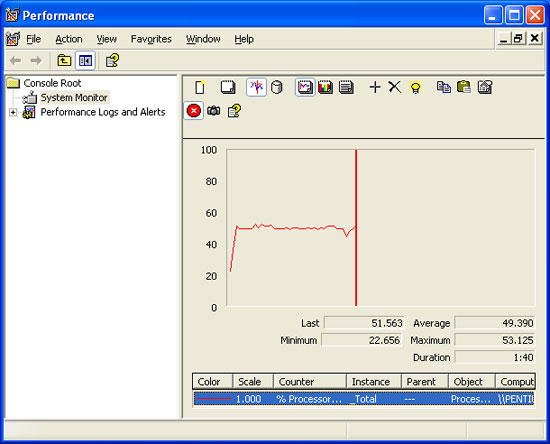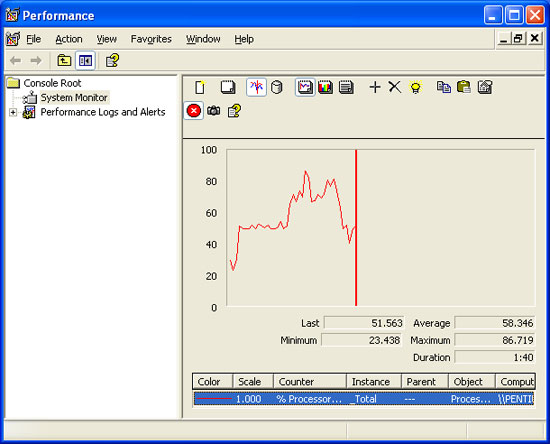Intel's Pentium Extreme Edition 955: 65nm, 4 threads and 376M transistors
by Anand Lal Shimpi on December 30, 2005 11:36 AM EST- Posted in
- CPUs
Multi-core support in Games?
Both Quake 4 and Call of Duty 2 now have SMP support, supposedly offering performance improvements on dual core and/or Hyper Threading enabled processors.
For Call of Duty 2, you simply install the new patch and off you go; SMP support is enabled. To verify, we ran our CoD 2 benchmark and kept a log of the total processor utilization over time. Below is a shot of perfmon with a fresh install of CoD2 (sans SMP patch):
Now, let's look at CoD2 CPU utilization with the SMP patch installed:
We looked at performance at 1024x768 and obviously the higher the resolution, the lesser the impact of a faster CPU (at the same time, the lower the resolution, the greater the impact will be as the game becomes less GPU limited).
To ensure a fair comparison, we tested using the SMP patch and simply disabled SMP manually by setting the r_smp_backend variable to "0". We confirmed that SMP support was actually disabled by running perfmon and measuring CPU utilization.
Surprisingly enough, we actually saw pretty large performance drops in CoD2 with SMP enabled across both AMD and Intel platforms. This is unfortunate, but the withdrawn SMP support of Quake 3 makes it less than shocking. We do expect that things will get better as time goes on.
Quake 4 was a different story; with r_useSMP enabled, we saw some extremely large performance gains with the move to dual core:
The SMP patch either only spawns two threads, or the instruction mix of Quake 4 with the patch does not mix well with Intel's Pentium EE 955. The dual core with Hyper Threading enabled platform didn't do anything at all for performance.
While we're only looking at two games, this is a start for multithreaded game development. You can expect to see a lot of examples where dual-core does absolutely nothing for gaming, but as time goes on, the situation will change.
Both Quake 4 and Call of Duty 2 now have SMP support, supposedly offering performance improvements on dual core and/or Hyper Threading enabled processors.
For Call of Duty 2, you simply install the new patch and off you go; SMP support is enabled. To verify, we ran our CoD 2 benchmark and kept a log of the total processor utilization over time. Below is a shot of perfmon with a fresh install of CoD2 (sans SMP patch):

Now, let's look at CoD2 CPU utilization with the SMP patch installed:

We looked at performance at 1024x768 and obviously the higher the resolution, the lesser the impact of a faster CPU (at the same time, the lower the resolution, the greater the impact will be as the game becomes less GPU limited).
To ensure a fair comparison, we tested using the SMP patch and simply disabled SMP manually by setting the r_smp_backend variable to "0". We confirmed that SMP support was actually disabled by running perfmon and measuring CPU utilization.
| Call of Duty 2 | SMP Disabled | SMP Enabled |
| AMD Athlon 64 FX-57 (2.8GHz) | 80.6 | N/A |
| AMD Athlon 64 X2 4800+ (2.4GHz) | 79.8 | 70.3 |
| AMD Athlon 64 X2 3800+ (2.0GHz) | 78.7 | 68.1 |
| Intel Pentium Extreme Edition 955 (3.46GHz) | 79.8 | 68.4 |
| Intel Pentium Extreme Edition 840 (3.2GHz) | 78.1 | 68 |
| Intel Pentium D 820 (2.8GHz) | 75.6 | 67.1 |
Surprisingly enough, we actually saw pretty large performance drops in CoD2 with SMP enabled across both AMD and Intel platforms. This is unfortunate, but the withdrawn SMP support of Quake 3 makes it less than shocking. We do expect that things will get better as time goes on.
Quake 4 was a different story; with r_useSMP enabled, we saw some extremely large performance gains with the move to dual core:
| Quake 4 | SMP Disabled | SMP Enabled |
| AMD Athlon 64 FX-57 (2.8GHz) | 115.4 | N/A |
| AMD Athlon 64 X2 4800+ (2.4GHz) | 114.9 | 147.4 |
| AMD Athlon 64 X2 3800+ (2.0GHz) | 100.9 | 143.2 |
| Intel Pentium Extreme Edition 955 (3.46GHz) | 98.9 | 142.3 |
| Intel Pentium Extreme Edition 840 (3.2GHz) | 89.0 | 133.6 |
| Intel Pentium D 820 (2.8GHz) | 80.6 | 125.5 |
The SMP patch either only spawns two threads, or the instruction mix of Quake 4 with the patch does not mix well with Intel's Pentium EE 955. The dual core with Hyper Threading enabled platform didn't do anything at all for performance.
While we're only looking at two games, this is a start for multithreaded game development. You can expect to see a lot of examples where dual-core does absolutely nothing for gaming, but as time goes on, the situation will change.










84 Comments
View All Comments
skunkbuster - Friday, December 30, 2005 - link
cramitpal is that you?coldpower27 - Friday, December 30, 2005 - link
This is the Pentium Extreme Edition of course it's price is going to be 999US.If you want cheaper Presler cores, wait for the Pentium D 920 to 950 line to com out in Mid January.
Betwon - Friday, December 30, 2005 - link
INQ says Presler 920 will be about 240$.It is very interesting that PD820 defeat FX-57 in a SMP game.
phaxmohdem - Friday, December 30, 2005 - link
Let's recap, the X2 4800+ was ahead in most tests, and at worst could probably be called the 955 EE's equivilent....
955EE = $999
4800+ = ~$785
Yeah, I'd definately recommend "sticking with AMD for now and re-evaluating Intel's offerings when Conroe arrives."
Did anyone else notice how the lowly 3800+ did better in most gaming scenarios?
955EE = $999
3800+ = ~$315
Tasty :)
GhandiInstinct - Friday, December 30, 2005 - link
LOL, honestly your post is the only necessary post here. It compares and contrats the two perfectly in terms of which is a better buy, given the reader has seen all of the benchmarks in which the 4800 beats the 955EE.Intel just can't win because of EGO.
Anemone - Friday, December 30, 2005 - link
Kudos because no matter where you sat personally you seemed to have called the shots fairly. I'd agree with the conclusion as well, that you are either Conroe or A64, that the P4 is an overdue dead end. It performs well, but it is hot and uses lots of electricity to do so. Overclocking wasn't needed because, quite frankly the X2 chips oc too, and you'd find they probably do it better.Socket M2 is again, something you "should" wait for if you can, as is Conroe. These are heavy recomendations, you really would be very smart to wait for these two things. Barring that, given the better of two bad options (meaning you have to upgrade now when you should be waiting), AMD is the better choice, partially for the power consumption, partially for the "less of a dead end than a P4" issue.
Still, heavy, heavy emphasis on "you should wait", as a complete changeover is going on with both AMD and Intel and your ability to perform minor upgrades 1-2 years from now will depend on waiting patiently for a few more months.
:)
JarredWalton - Friday, December 30, 2005 - link
Socket M2 doesn't appear to be anything special. Why wait 6 months for a 5% performance boost and a RAM change? Just like waiting for Prescott ended up being much ado about nothing, M2 isn't going to be wildly different from today's 939 chips. Get a good socket 939 system with an X2 and SLI, and you should be set for at least 18 months.Calin - Tuesday, January 3, 2006 - link
I don't find SLI important - except for the possibility to run two top of the line video cards. And increased speed won't come from higher RAM speed - not so much anyway in order to keep you waiting.I just wonder how long will the Socket 939 be kept - considering that the value line is the cheaper Socket 754 (cheaper in having a single memory channel, so half as many lines to memory banks). Or if Socket 754 will be abandoned before Socket 939, or if Socket M2/2 (single channel DDR2 memory) will appear.
nserra - Friday, December 30, 2005 - link
Two cores on the same packing is an excellent idea!Will amd do that with m2?
Could lower the dual core price and even at 90nm could put 2 dual core processors on the same packing and build a 4 core processor (fake one, but 4 cores there).
ViRGE - Friday, December 30, 2005 - link
The problem with 2 physical cores is that you're forgoing any sort of on-die communication benefits by doing so. It's certainly cheaper for Intel to make things this way, but it's a poor way to go for performance, as it makes it harder for the cores to quickly send data to each other and share resources. It's certainly a valid solution(especially given how Intel didn't have any inter-core communication even when both cores were on the same die), but ultimately a combined die for inter-core communication is superior for performance and scaling.